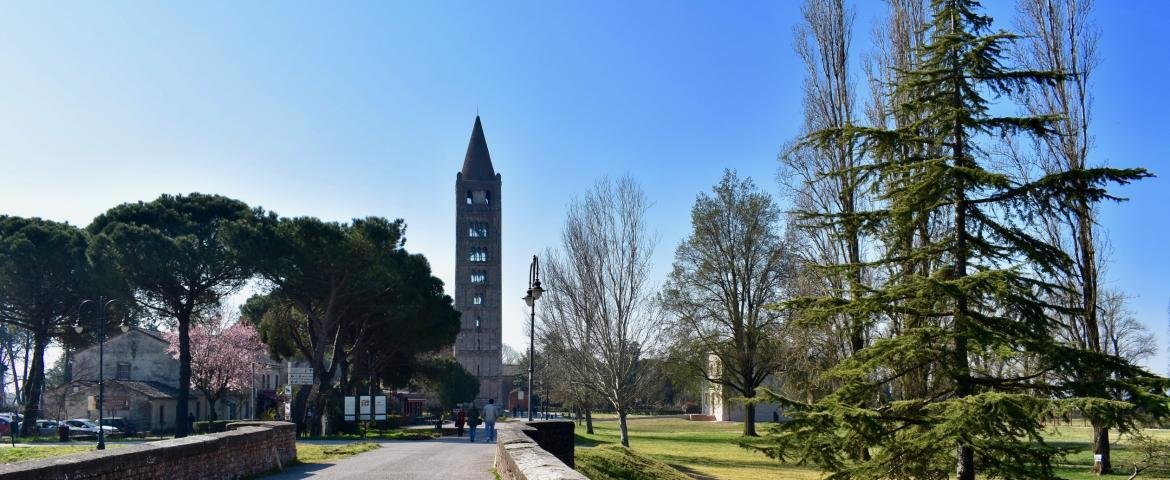
A place of prayers and patient land reclamation: the monastic centre where the seventh musical note was added to the scale
❝The Abbey of Pomposa is one of the most remarkable examples of medieval religious architecture in Italy. Between the branches of the Po di Goro and the Po di Volano, in the lands of the ancient "Insula Pomposia", this Benedictine monastery guided important land reclamation works. For centuries, monks preserved ancient knowledge and offered refuge to travellers like Dante Alighieri. Also within these walls, Guido d'Arezzo introduced the seventh note of the musical scale.❞
Over the centuries, the Po Delta area has undergone very complex evolutionary processes. In the Middle Ages its appearance was very different from what can be seen in maps today. Several factors have changed its morphology, first of all the historical land reclamation carried out by the Benedictine monks, who made habitable and cultivatable vast areas of land that were previously marshland. Before the drainage and water regulation work, the landscape near Pomposa probably looked like an expanse of low, swampy and uncultivated lands, interspersed with thick woods and inadequate lake basins.
The first monks came here from Byzantium around the 6th-7th century, in order to evangelize a territory that had been devastated by the collapse of the Roman Empire and by war. Here they built a small church, as shown in the archaeological findings present in the small apse on the left of the church.
The original core of the abbey stood within the so-called “Insula Pomposia”, a dense wooded area located between the Po di Goro, the Po di Volano and the Adriatic Sea. In the centuries that followed the presence of the Benedictines it was further strengthened, with the consequent development of an actual abbey complex, which reached its maximum splendour after the year 1000. The abbey was built at an appropriate distance from the inhabited centres, on the one hand so as to make sure the monks could enjoy the isolation necessary for prayer, and on the other hand to ensure the involvement of the population of neighbouring communities in the island's hydraulic and agricultural reorganization.
The abbey, which throughout the Middle Ages constituted an important centre of culture and innovation in many fields (Guido d'Arezzo also taught there and invented modern musical notation with the addition of the Seventh note), was located along the ancient Via Popilia (today the "Strada Romea"): a busy thoroughfare used by pilgrims from all over central and eastern Europe on their way to Rome or to the Holy Land. The Popilia, also known as the "via del sale" (the salt road), was also used by wealthy pilgrims, who found refreshment in the abbey, fulfilled vows and promises made to God and sometimes left large donations. Giotto was one such frequent visitor, the creator of the splendid frescoes in the Sala Capitolare: they were probably bequeathed by Giotto during the artistic journey that took him from Rimini to Padua in the early 14th century.
Another famous person who stayed in Pomposa was Dante Alighieri, who stopped off on his travels between Ravenna, Venice and Verona. In the abbey he certainly was able to admire the frescoes of the Last Judgment and the floor mosaics, such as the splendid paved floor (“litostroto”) with concentric circles near the entrance. It is likely that these colourful artistic expressions were also a source of inspiration for some images in the Divine Comedy. The Abbey of Pomposa is referred to explicitly in some passages of Canto XXI of Paradiso and Canto V of Purgatorio.
By train: the abbey is situated about 6 km from Codigoro station (railway line Ferrara-Codigoro), with good cycle-rail interchange facilities.
Opening times for visitors:
Abbazia di Pomposa
Where to eat:
we suggest Ristorante e Resort Oasi Bianca and Hotel Ristorante Oasi Cannevié.
Where to stay:
we recommend B&B Rospo Smeraldino (Via Giralda Centrale 1, Codigoro; tel. 333 8016565) and Locanda del Passo Pomposa.
Tours and bike & boat rental:
for bike and horse trips and boat tours please refer to the website of Parco Delta del Po.